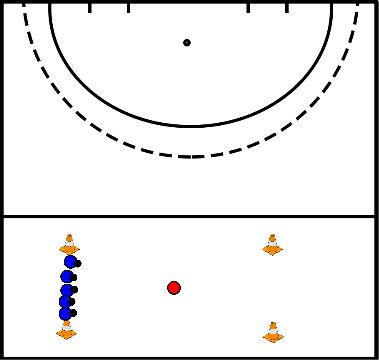Hockey drills for technique dribbling
- Party game with two goals and a square in the middle of the field.
- The ball may not be played through the square. In that case the ball is in touch.
- So the idea is to play field hockey outside and not through the axis of the field.
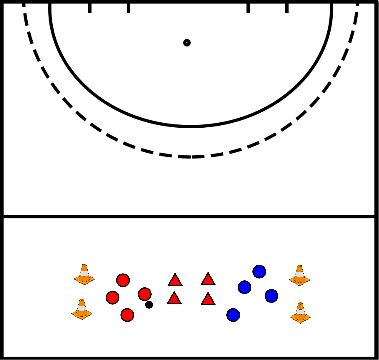
Relay
- Make two equal teams; team red and team blue.
- Start with ball at orange pawn.
- Float a lap around the green pawns and place ball with hand on pawn red.
- Then run a lap around the green pawns without ball and tap the blue pawn with your hand.
- Then walk another circle around the green pawns and take the ball off the red pawn.
- Then drive a circle around the green pawns with ball and pass the ball to the next one.
Note:
- Depending on the number of players, you can have everyone take 1, 2 or 3 turns.
- Once a player has had her/his last turn, she/he sits on the floor.
- If a team has all its players sitting on the ground, they win the relay.
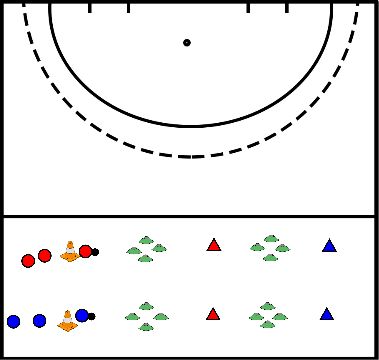
- With a walk-in ball
- Playing a right front
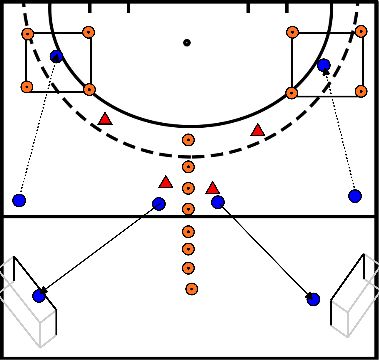
Relay 4
- Players blue and red start at the same time with the ball
- Slalom around the 5 pawns --> cross --> around the green pawn and finish on goal.
- If you score, you may immediately choose the shortest path to tap your next teammate.
- If you miss; wide, post or the ball does not reach the goal, you make a detour via the red or blue pawn/triangle.
- Players blue run back via the blue pawn and players red via the red.
- When you have been, you sit on the ground.
- The team that has all players on the ground first wins the relay.
- Depending on the number of players, you may choose to have all players take their turn twice.
- Switch sides halfway through the exercise.
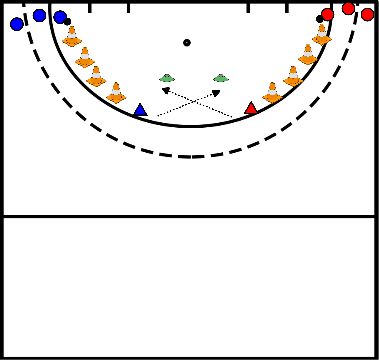
Rats versus Ravens
- Players red; the rats and players blue; the ravens all have a ball and stand with their backs to each other.
- Trainer says r(rrrr)atten: all red players drift with ball toward the pawn line; players blue leave their ball and try to tap players red for the line.
- The trainer says r(rrrr)aven: all blue players drive ball toward the pawn line; players red leave their ball and try to tap players blue for the line.
- Reach the line without being tapped, you get a point.
- Tap the player red/ blue before the line you get a point.
- Change opponents frequently.
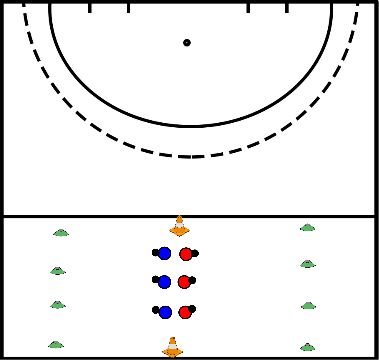
- All players start with a ball in the square and dribble/drive around in it.
- The trainer determines the moment to call stop!
- At that moment, all players make sure the ball is stopped as quickly as possible.
- Does the ball roll on. So does the player not have control of the ball he is off.
- When you are off, you wait by the side.
- The trainer may point to a waiting player to call stop!
- As a trainer, at some point you may indicate that the players should dribble faster.
- This makes it more difficult to stop the ball.
Note: the ball must be really still, so it should not roll a little bit.
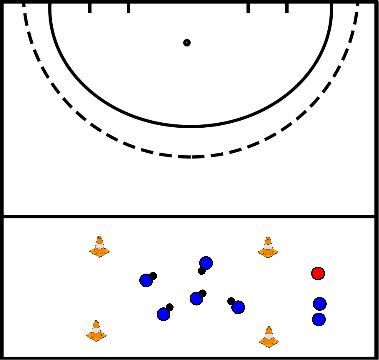
- Except for one player -red-, all players -blue- have one ball.
- The red defender tries to work all balls out of the box.
- If a blue player loses his/her ball and it has been played out of the box, she/he stands with her/his legs apart.
- The player can be redeemed by another blue player; This one plays the ball through the legs -panna- and blue has a player back in the box.
- Continue until all players are off.
Points of attention:
- If it takes too long or you notice in advance that one defender is too little, appoint an extra defender.
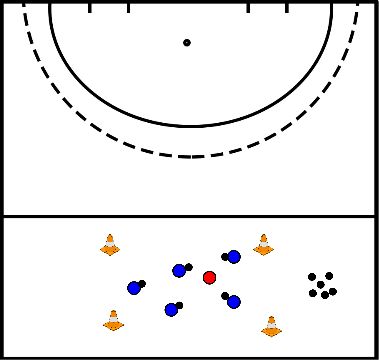
Three-color game
- Players all have a ball and dribble through the box of pawns.
- Scattered through the box are pawns of three different colors; at least 4 of each color.
- Trainer has in hand of all three colors -i.e. in the example red, blue and white.
- Trainer puts e.g. a blue pawn in the air --> All players try to drive around all blue pawns as quickly as possible.
- The first two players who have driven around all blue pawns get a point.
- Then a new round begins and the trainer chooses another color pawn -or the same color.
- Etc.
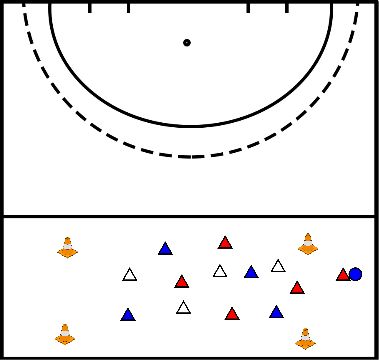
Relay
- As trainers, create two equal teams.
- Start the relay at the trainer's signal.
- The players slalom around the pawns. Both ball and body around the pawns. And rounds on goal; push or flatten.
- If the player scores, he may immediately sprint back and tap the next player.
- If the player misses, he must take a detour via the blue pawn at the side of the field and then sprint back and tap the next player.
- When it's your turn, you sit on the floor.
- Depending on the number of players, you can also choose to have all players take 2 or 3 turns.
- The next player may not start until he is tapped by the player in front of him.
- The team that has all players on the ground first wins the relay.
- There are different types of slalom to apply in this exercise:
- Normal slalom
- Slalom in which the player's body and ball are to the left or right of the pawn line
- Slalom where the ball is to the left of the row of pawns and the body is to the right
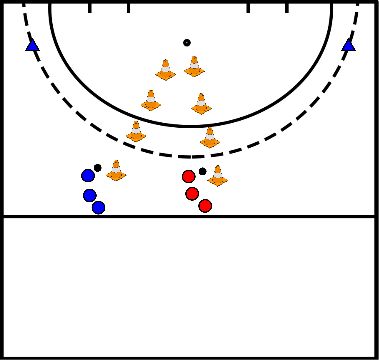
- The trainer makes two equal teams and divides them into two rows.
- The first player on each team starts with a slalom around the green pawns.
- Then he drives a lap around the blue pawns -right around.
- He puts the ball on the orange pawn and sprints back to the row of players.
- There he taps the next player.
- This one does exactly the same thing only without ball and stick.
- He picks up the ball from the cone and sprints back to the row.
- There he puts the ball ready for the next player, who travels the route again with ball and stick, and so on.
- The team that first, has all its players finish twice, is the winner of the game.
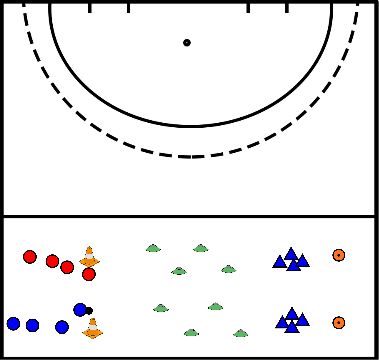
1 vs. 1
- The trainer sets out a square and gathers all the balls and players in it.
- The trainer gives all players a number. In this example, 1 through 6.
- The trainer calls out two numbers each time. In this example 3 and 5.
- The player with number 3 plays a 1 vs. 1 against the player with number 5.
- The player who scores a goal gets a point.
- Then the coach calls two other numbers, after which a new 1 vs. 1 is played.
- The players keep track of how many points they have made.

Overrun
- All but one player start with ball on the line.
- They try to reach the other side of the field without losing the ball.
- The defender -player red- tries to take the ball from the players -blue- and work it out of the box.
- If a player loses his ball and the ball is played out of the box then he is finished.
- He then helps the defender to take the balls off and work them out of the box.
- The game continues until all players are finished.
- The player last left wins the game.
Points of Attention:
- Is the game finished, start over with another defender.
- If the player commits a foul, he is also finished.
